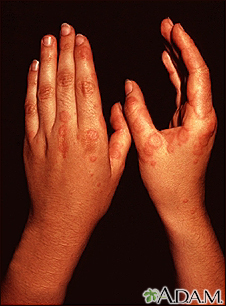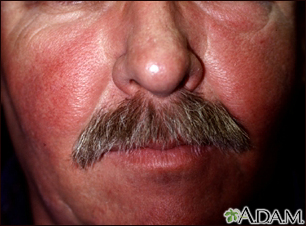Rashes
Rashes involve changes in the color, feeling or texture of your skin.
Considerations
Often, the cause of a rash can be determined from how it looks and its location and symptoms. Skin testing, such as a scraping, culture, or biopsy, may also be used to help with diagnosis. Sometimes, the cause of the rash remains unknown.
Biopsy
A biopsy is the removal of a small piece of tissue for lab examination.

Causes
A rash is often due to dermatitis, meaning inflammation of the skin. Contact dermatitis is caused by things your skin touches, such as:
Contact dermatitis
Contact dermatitis is a condition in which the skin becomes red, sore, or inflamed after direct contact with a substance.

- Chemicals in elastic, latex, and rubber products
- Cosmetics, soaps, and detergents
- Dyes and other chemicals in clothing
- Poison ivy, oak, or sumac
Poison ivy, oak, or sumac
Poison ivy, oak, and sumac are plants that commonly cause an allergic skin reaction. This is also called an allergic contact dermatitis. The result...
 ImageRead Article Now Book Mark Article
ImageRead Article Now Book Mark Article

Rash
A rash is an eruption of changes in color or texture of the skin.
Seborrheic dermatitis is a rash that appears in patches of redness and scaling around the eyebrows, eyelids, mouth, nose, trunk, and behind the ears. If it happens on your scalp, it is called dandruff in adults and cradle cap in infants.
Seborrheic dermatitis
Seborrheic dermatitis is a common inflammatory skin condition. It causes flaky, white to yellowish scales to form on oily areas such as the scalp, f...

Age, stress, fatigue, weather extremes, oily skin, infrequent shampooing, and alcohol-based lotions aggravate this harmless but bothersome condition.
Fatigue
Fatigue is a feeling of weariness, tiredness, or lack of energy.

Other common causes of a rash include:
- Eczema (atopic dermatitis) -- Tends to happen in people with allergies or asthma. The rash is generally red, itchy, and scaly.
Eczema
Atopic dermatitis is a long-term (chronic) skin disorder that involves scaly and itchy rashes. It is a type of eczema. Other forms of dermatitis inc...
 ImageRead Article Now Book Mark Article
ImageRead Article Now Book Mark Article - Psoriasis -- Tends to occur as red, scaly, patches over joints and along the scalp. It is sometimes itchy. Fingernails may also be affected.
Psoriasis
Psoriasis is a skin condition that causes skin redness, silvery scales, and irritation. Most people with psoriasis have thick, red, well-defined pat...
 ImageRead Article Now Book Mark Article
ImageRead Article Now Book Mark Article - Impetigo -- Common in children, this infection is from bacteria that live in the top layers of the skin. It appears as red sores that turn into blisters, ooze, then form a honey colored crust over all or part of the rash.
Impetigo
Impetigo is a common infection of the outermost layer of the skin.
 ImageRead Article Now Book Mark Article
ImageRead Article Now Book Mark Article - Shingles -- A painful blistered skin condition caused by the same virus as chickenpox. The virus can lie dormant in your body for many years and re-emerge as shingles. It usually affects only one side of the body.
Shingles
Shingles is a painful, blistering skin rash. It is caused by the varicella-zoster virus, a member of the herpes family of viruses. This is the viru...
 ImageRead Article Now Book Mark Article
ImageRead Article Now Book Mark Article - Childhood illnesses such as chickenpox, measles, roseola, rubella, hand-foot-mouth disease, fifth disease, and scarlet fever.
Chickenpox
Chickenpox is a viral infection in which a person develops very itchy blisters all over the body. It was more common in the past. The illness is ra...
 ImageRead Article Now Book Mark Article
ImageRead Article Now Book Mark ArticleMeasles
Measles is a very contagious (easily spread) illness caused by a virus.
 ImageRead Article Now Book Mark Article
ImageRead Article Now Book Mark ArticleRoseola
Roseola is a viral infection that commonly affects infants and young children. It involves a pinkish-red skin rash and high fever.
 ImageRead Article Now Book Mark Article
ImageRead Article Now Book Mark ArticleRubella
Rubella, also known as the German measles, is an infection in which there is a rash on the skin. Congenital rubella is when a pregnant woman with rub...
 ImageRead Article Now Book Mark Article
ImageRead Article Now Book Mark ArticleHand-foot-mouth disease
Hand-foot-mouth disease is a common viral infection that most often begins in the throat.
 ImageRead Article Now Book Mark Article
ImageRead Article Now Book Mark ArticleFifth disease
Fifth disease is caused by a virus that leads to a rash on the cheeks, arms, and legs.
 ImageRead Article Now Book Mark Article
ImageRead Article Now Book Mark ArticleScarlet fever
Scarlet fever is caused by an infection with bacteria called group A streptococcus. This is the same bacteria that cause strep throat.
 ImageRead Article Now Book Mark Article
ImageRead Article Now Book Mark Article - Medicines
- Insect bites or stings.
Insect bites or stings
Insect bites and stings can cause an immediate skin reaction. The bite from fire ants and the sting from bees, wasps, and hornets are most often pai...
 ImageRead Article Now Book Mark Article
ImageRead Article Now Book Mark Article
Many medical conditions can cause a rash as well. These include:
- Lupus erythematosus (an immune system disease)
Lupus erythematosus
Systemic lupus erythematosus (SLE) is an autoimmune disease. In this disease, the immune system of the body mistakenly attacks healthy tissue. It c...
 ImageRead Article Now Book Mark Article
ImageRead Article Now Book Mark Article - Rheumatoid arthritis, especially the juvenile type
Rheumatoid arthritis
Rheumatoid arthritis (RA) is a disease that leads to inflammation of the joints and surrounding tissues. It is a long-term disease. It can also aff...
 ImageRead Article Now Book Mark Article
ImageRead Article Now Book Mark ArticleJuvenile type
Juvenile idiopathic arthritis (JIA) is a term used to describe a group of disorders in children that includes arthritis. They are long-term (chronic...
Read Article Now Book Mark Article - Kawasaki disease (inflammation of the blood vessels)
Kawasaki disease
Kawasaki disease is a rare condition that involves inflammation of the blood vessels. It occurs in children.
 ImageRead Article Now Book Mark Article
ImageRead Article Now Book Mark Article - Certain body-wide (systemic) viral, bacterial or fungal infections
Home Care
Many simple rashes will improve with gentle skin care and by avoiding irritating substances. Follow these general guidelines:
- Avoid scrubbing your skin.
- Use gentle cleansers.
- Avoid applying cosmetic lotions or ointments directly on the rash.
- Use warm (not hot) water for cleaning. Pat dry, don't rub.
- Stop using any recently added cosmetics or lotions.
- Leave the affected area exposed to the air as much as possible.
- Try calamine medicated lotion for poison ivy, oak, or sumac, as well as for other types of contact dermatitis.
Hydrocortisone cream (1%) is available without a prescription and may soothe many rashes. Stronger hydrocortisone or other steroid creams are available with a prescription. If you have eczema, apply moisturizers over your skin. Try oatmeal bath products, available at drugstores, to relieve symptoms of eczema or psoriasis. Oral antihistamines may help relieve itchy skin.
When to Contact a Medical Professional
Call 911 or the local emergency number if:
- You are short of breath, your throat is tight, or your face is swollen.
- Your child has a purple rash that looks like a bruise.
Contact your health care provider if:
- You have joint pain, fever, or a sore throat.
Fever
Fever is the temporary increase in the body's temperature in response to a disease or illness. A child has a fever when the temperature is at or abov...
 ImageRead Article Now Book Mark Article
ImageRead Article Now Book Mark ArticleSore throat
Pharyngitis, or sore throat, is discomfort, pain, or scratchiness in the throat. It often makes it painful to swallow.
 ImageRead Article Now Book Mark Article
ImageRead Article Now Book Mark Article - You have streaks of redness, swelling, or very tender areas as these may indicate an infection.
- You are taking a new medicine. Do not change or stop any of your medicines without contacting your provider.
- You may have a tick bite.
Tick bite
Ticks are bugs that can attach to you as you brush past bushes, plants, and grass. Once on you, ticks often move to a warm, moist place on your body...
 ImageRead Article Now Book Mark Article
ImageRead Article Now Book Mark Article - Home treatment doesn't work, or your symptoms get worse.
What to Expect at Your Office Visit
Your provider will perform a physical exam and ask about your medical history and symptoms. Questions may include:
- When did the rash begin?
- What parts of your body are affected?
- Does anything make the rash better? Worse?
- Have you used any new soaps, detergents, lotions, or cosmetics recently?
- Have you been in any wooded areas recently?
- Have you noticed a tick or insect bite?
- Have you had any change in your medicines?
- Have you eaten anything unusual?
- Do you have any other symptoms, like itching or scaling?
Itching
Itching is a tingling or irritation of the skin that makes you want to scratch the area. Itching may occur all over the body or only in one location...
 ImageRead Article Now Book Mark Article
ImageRead Article Now Book Mark Article - What medical problems do you have, such as asthma or allergies?
Asthma
Asthma is a chronic disease that causes the airways of the lungs to swell and narrow. It leads to breathing difficulty such as wheezing, shortness o...
 ImageRead Article Now Book Mark Article
ImageRead Article Now Book Mark ArticleAllergies
An allergy is an immune response or reaction to substances that are usually not harmful.
 ImageRead Article Now Book Mark Article
ImageRead Article Now Book Mark Article - Have you recently traveled out of the area where you live?
Tests may include:
- Allergy testing
Allergy testing
Allergy skin tests are used to find out which substances cause a person to have an allergic reaction. These substances are called allergens....
 ImageRead Article Now Book Mark Article
ImageRead Article Now Book Mark Article - Blood tests
- Skin biopsy
- Skin scrapings
Depending on the cause of your rash, treatments may include medicated creams or lotions, medicines taken by mouth, or skin surgery.
Many primary care providers are comfortable dealing with common rashes. For more complicated skin disorders, you may need a referral to a dermatologist.
Reviewed By
Elika Hoss, MD, Assistant Professor of Dermatology, Mayo Clinic, Scottsdale, AZ. Also reviewed by David C. Dugdale, MD, Medical Director, Brenda Conaway, Editorial Director, and the A.D.A.M. Editorial team.
James WD, Elston DM, Treat JR, Rosenbach MA, Neuhaus IM. Cutaneous signs and diagnosis. In: James WD, Elston DM, Treat JR, Rosenbach MA, Neuhaus IM, eds. Andrews' Diseases of the Skin. 13th ed. Philadelphia, PA: Elsevier; 2020:chap 2.
Ko CJ. Approach to skin diseases. In: Goldman L, Cooney KA, eds. Goldman-Cecil Medicine. 27th ed. Philadelphia, PA: Elsevier; 2024:chap 403.















 All rights reserved.
All rights reserved.